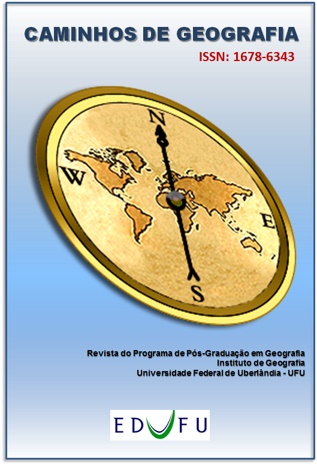MODELO PARA IDENTIFICAÇÃO DA QUALIDADE DE FRAGMENTOS DE VEGETAÇÃO NATIVA: ESTUDO DE CASO DA BACIA DO RIO PIRACICABA /MG
DOI:
https://doi.org/10.14393/RCG228356265Palavras-chave:
Fragmentação, Biogeografia, Biogeografia, Métricas da vegetação, Métricas da vegetaçãoResumo
A fragmentação de habitats impacta a biodiversidade no sentido de reduzi-los nos níveis de organização estrutural, taxonômica e funcional, bem como genético, específico e ecossistêmico. Apesar de possíveis causas naturais, ela tem sido intensificada pela ação antrópica. Habitats naturais têm sido transformados em mosaicos paisagísticos onde manchas de vegetação nativa se diluem entre áreas modificadas. A fragmentação induz a perda da qualidade do habitat por, entre outros motivos, modificar a sua forma e métrica, potencializando a vulnerabilidade ambiental. Além da perda da qualidade de hábitat, a fragmentação reduz as taxas de migração e/ou recolonização de espécies. Dessa forma, o objetivo desta pesquisa foi elaborar um modelo de mensuração de qualidade de fragmentos de vegetação nativa, baseado em sua métrica. Para atingir os objetivos foram selecionadas as variáveis, tamanho do fragmento, isolamento e índice de circularidade. Para o processamento dos dados, foi utilizado o software ArcGis. O modelo criado foi aplicado à bacia do rio Piracicaba-MG. Observou-se maior concentração de vegetação nativa na região meridional da bacia, onde estão localizadas as nascentes dos principais tributários do rio principal. Cerca de 80% dos fragmentos de vegetação foram classificados como dotados de qualidade muito alta, ou seja, são mais propícios à conservação.
Downloads
Downloads
Publicado
Edição
Seção
Licença
Autores que publicam nesta revista concordam com os seguintes termos: a) Autores mantém os direitos autorais e concedem à revista o direito de primeira publicação, com o trabalho licenciado sob a Creative Commons Atribuição-NãoComercial-SemDerivações 4.0 Internacional. b) Autores têm permissão e são estimulados a publicar e distribuir seu trabalho online (ex.: em repositórios institucionais ou na sua página pessoal), já que isso pode gerar alterações produtivas, bem como aumentar o impacto e a citação do trabalho publicado. c) Em virtude de aparecerem nesta revista de acesso público, os artigos são de uso gratuito, com atribuições próprias, em aplicações educacionais e não-comerciais.











